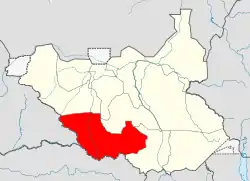Western Equatoria
Western Equatoria is a state in South Sudan. It has an area of 79,343 square kilometres (30,635 sq mi). Its capital is Yambio. The state was divided into counties, each headed by a County Commissioner. Western Equatoria seceded from Sudan as part of the Republic of South Sudan on 9 July 1956. On October 2, 2011, the state was divided into Amadi, Maridi, and Gbudwe states, and Tambura State was split from Gbudwe state on January 14, 2015. Western Equatoria was re-established by a peace agreement signed on 22 February 2020.[2]
Western Equatoria | |
|---|---|
 Flag | |
| Nickname(s): The Green State | |
| Motto(s): State Under God's Control | |
 Location in South-West of South Sudan. | |
| Coordinates: 05°19′N 28°24′E | |
| Country | |
| Region | Equatoria |
| No. of counties: | 10 |
| Province/State | 1976/1995 |
| Capital | Yambio |
| Government | |
| • Type | Autocracy System |
| • Governor | Maj. General Alfred Futiyo Karaba |
| Area | |
| • Total | 79,342.66 km2 (30,634.37 sq mi) |
| Population (2008 census) | |
| • Total | 1,619,029 |
| • Density | 20/km2 (53/sq mi) |
| Time zone | UTC+3 (EAT) |
| Area code(s) | 211 |
| HDI (2018) | 0.461[1] low · 2nd of 10 |

.jpg.webp)
History
Since the 16th century, Western Equatoria has been a home to the Avukaya, Azande, Baka, Moru, Mundu and Balanda.
The Mahdist Revolt of the 1880s destabilized the nascent province, and Equatoria ceased to exist as an Egyptian outpost in 1889. Important settlements in Equatoria included Lado, Gondokoro, Dufile and Wadelai. European colonial maneuverings in the region came to a head in 1898, when the Fashoda Incident occurred at present-day Kodok; Britain and France almost went to war over the region.[21] In 1947, British hopes to join South Sudan with Uganda, while leaving Western Equatoria as part of Belgian Congo were dashed by the Juba Conference to unify North and South Sudan.
The administration of King Gbudwe was known as the Azande kingdom or Mbomu Kingdom of the entire Azande of, Democratic Republic of the Congo (Zaire), Central African Republic and Equatoria (South Sudan) until the early 1900s, after when the British in-vain several attempt were finally able to captured King Gbudwe and killed him in 1905 which brought an end to the Azande Kingdom to present day. The Azande who is the majority in the state as well as the entire Equatoria Region, have had good relations with their neighbors, namely the Moru, Mundu, Pöjulu, Avukaya, Baka, Balanda and other small groups in Bahr El Ghazal, due to the expansionist policy of king Gbudwe, in the 18th century. In the 19th century, the Azande fought & defeated several Europeans colonials including the French, the Belgian French, British and the Mahdists to maintain their independence. Egypt, under the rule of Khedive Ismail Pasha, first attempted to control the region in the 1870s, establishing the province of Equatoria in the southern portion. Egypt's first governor was Samuel Baker, commissioned in 1869, followed by Charles George Gordon in 1874 and by Emin Pasha in 1878.[21]
In the middle of twentieth century, after Sudan's independence in 1956, Western Equatorians have sacrificed their life for over 5 decades liberating in movements for the independence of South Sudanese, including the Anya Nya led by, Joseph Lagu and the Sudan People's Liberation Army/Movement (SPLA/M), led by John Garang de Mabior, as they envisioned of New Sudan. Western Equatoria was also known as, the breadbasket state for liberators during both civil war.
Western Equatoria was separated from its sister State of Eastern Equatoria, becoming a Province in 1976[3] and the two Equatoria Provinces was once again inaugurated into 3 statehoods of Western Equatoria, Central Equatoria and Eastern Equatoria in the midst of the 1990s. Hence, there was a plan to re-unify the 3 sister states back into regionhood after the implementation of South Sudan's Federal System. But many suggested the three states should remain in place with each Governor, while having a Governor General to oversee the Greater Equatoria Region.
Current conflict
In 2005 a peace treaty was signed, but there was still some insurgent activity until dissolution.
The Lord's Resistance Army (LRA), under the command of Joseph Kony, moved its base from Uganda to the South Sudan border with the Democratic Republic of Congo, and operated in the Western Equatoria State. Before the 2005 peace deal, the LRA had used Western Equatoria as a base for its operations against the Ugandan government of President Yoweri Museveni. But the Arrow boys managed to defeat the LRA after SPLA troop failed to control the situation despite their heavily patrol in the region.
In 2009 local communities in Western Equatoria formed a self-protection unit, the Arrow Boys, using traditional weapons such as bows, arrows and spears to combat the LRA.
In 2020, Many Western Equatorians are joining hand together with their Central and Eastern Equatorian brothers/sisters in calling for Confederated United South Sudan or an Independent Federal Democratic Republic of Equatoria due to heavy marginalization, forceful rapping of Equatorian women or the brutality abuses of Equatorian men/women by non-Equatorians, massive land grabbing in Equatoria and cold bloodily killing of Equatorians. Enlighten of the above, Equatorians across the 3 Equatoria's States of Western, Central and Eastern Equatoria under EPA (Equatorian People's Alliance) lead by Dr. Hakim Dario, started to advocating for a Confederated United Republic of South Sudan or else declared their own Independent Federal Democratic Republic of Equatoria. This will be inline, if the Government of The Republic of South Sudan doesn't comply or accept a confederated states of: Bahr El-Ghazal, Equatoria and Upper Nile Regions within a unify Confederated South Sudan.
Counties
There are 10 counties in Western Equatoria:
- Yambio County Capital: Yambio
- Nzara County Capital: Nzara
- Ibba County Capital: Ibba
- Ezo County Capital: Ezo
- Maridi County Capital: Maridi
- Tombura County Capital: Tombura
- Mundri West County Capital: Mundri
- Mvolo County Capital: Mvolo
- Nagero County Capital: Nagero
- Mundri East County Capital: Kedi'ba
Other important towns in Western Equatoria were: Nagero, Duma, Namutina, Jambo, Rasul, Tore, Muroko, Manguo, Mambe, Kotobi, Yarri, Farak Sika, Madebe, Bangasu, Rimenze, Bazungua, Makpandu, Nadiangere, Kua Diko, Ri-Rangu, Nabiapai, Gangura, Birisi, Ndoromo, Bangazagino, sangua, Basukangbi Ringasi, Diabio, Yangiri, Bafuka, Naandi, Andari, Ri-Yubu, Mopai and Sakure.
Governor of Western Equatoria
- 1976 — 1982 H.E Barnaba Kisanga
- 1982–1984 H.E Charles Ali Bilal
- 1984 – 1984 H.E Samuel Abu-John Kabbashi **Lasted 7 days only on first term**
- 1984–1985 H.E James Bazia
- 1985–1987 H.E Brig. Dominic Kassiano Dombo
- 1987–1989. H.E Raphael Zamoi
- 1989–1991 H.E Brig. Dominic Dabi Monango
- 1994–2005 *** Due to war in the state, multiple Commissioners/Governors Governed based in Khartoum, Sudan***
- 2005 — 2005 H.E Maj. General Patrick Zamoi **Lasted 6-7 months only on first term**
- 2005–2008 H.E Samuel Abu-John Kabbashi "Died while serving"
- 2008–2010 H.E Nunu Jama Kumba
- 2010–2013 H.E Col. Joseph B. Bakosoro
- 2013–2015 H.E Maj. General Patrick Zamoi "Served till the state was divided into multiple states, then he served as Governor of Tombura State until Western Equatoria State was restored back to a single state"
- 2015–2020 **Ununified 6 States Governors**
- 2020 — Present H.E Maj. General Alfred Futiyo Karaba
Economy and demographics
The economy of Western Equatoria is largely agricultural, with high quality timber being one of its most important products.
Western Equatoria region is the home of the Azande people, the second largest tribes in South Sudan, The Moru, Baka, Avukaya, Bare, Bongo and Jur tribes.[4]
References
- "Sub-national HDI – Area Database – Global Data Lab". hdi.globaldatalab.org. Retrieved 2020-04-18.
- Aljazeera Feb 2020
- Badiey, Naseem (2014). The State of Post-conflict Reconstruction: Land, Urban Development and State-building in Juba, Southern Sudan. p. 48. ISBN 978-1-84701-094-0.
- Gurtong Azande Retrieved: 22 September 2010